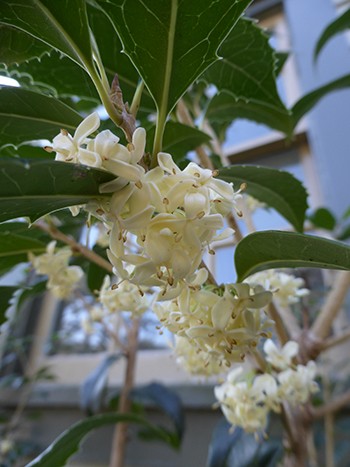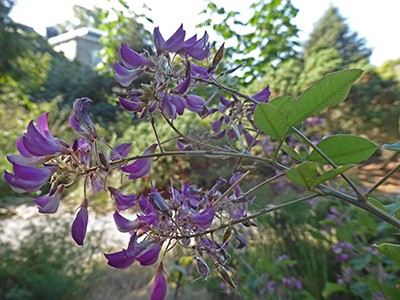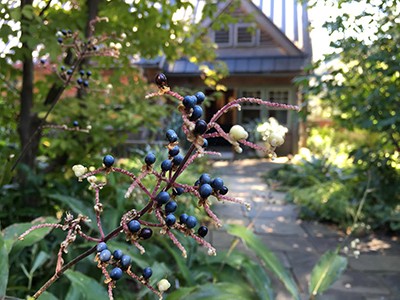Plant of the Week: October 31
 The element of surprise fragrance in the garden appeals to both the sense of smell and one’s curiosity. Just where is that scent coming from? Osmanthus x fortunei with its clusters of creamy white flowers provides a sweet greeting to visitors entering the front door of the Cunningham House. The source of the odor isn’t obvious as the holly-like foliage conceals the blossoms. An evergreen shrub, Osmanthus x fortunei can grow upwards of 20’ yet responds well to shearing and is easily kept to more restrained heights. Plant in full sun for dense growth and abundant flowering. Photo credit: J. Coceano
The element of surprise fragrance in the garden appeals to both the sense of smell and one’s curiosity. Just where is that scent coming from? Osmanthus x fortunei with its clusters of creamy white flowers provides a sweet greeting to visitors entering the front door of the Cunningham House. The source of the odor isn’t obvious as the holly-like foliage conceals the blossoms. An evergreen shrub, Osmanthus x fortunei can grow upwards of 20’ yet responds well to shearing and is easily kept to more restrained heights. Plant in full sun for dense growth and abundant flowering. Photo credit: J. Coceano
 Lespedeza, often known as bush clover, has traditionally been used as an agricultural crop, particularly in the southern United States as a means of soil enrichment and erosion control. This legume procures nitrogen from the air and transforms it into a soil-bound form that can be used by other plants. There are dozens of species, some of which are highly ornamental. Lespedeza bicolor ‘Yakushima’ is one such garden-worthy plant. ‘Yakushima’ is a dwarf-mounding selection producing sprays of purple pea flowers in late summer through early autumn. Reaching a mere 3’ in width it is ideal for a sunny section of the garden border. Photo credit: J. Coceano
Lespedeza, often known as bush clover, has traditionally been used as an agricultural crop, particularly in the southern United States as a means of soil enrichment and erosion control. This legume procures nitrogen from the air and transforms it into a soil-bound form that can be used by other plants. There are dozens of species, some of which are highly ornamental. Lespedeza bicolor ‘Yakushima’ is one such garden-worthy plant. ‘Yakushima’ is a dwarf-mounding selection producing sprays of purple pea flowers in late summer through early autumn. Reaching a mere 3’ in width it is ideal for a sunny section of the garden border. Photo credit: J. Coceano
 The Terry Shane Teaching Garden features many Asian plant genera such as Epimedium, Aucuba, and Arisaema. Another Asian native dotted throughout the garden is Pollia japonica. Pollia bears shiny ginger-like leaves and modest white flowers atop extended stalks. This rhizomatous perennial dies back to the ground every winter. Spreading via below-ground rhizomes, I find the plant to be a great filler, popping up amongst other shrubs and perennials, yet not overbearing or weedy. Unwanted plants are easily pulled out. White flowers give rise to fruits that change color from smoky blue to dark purple and black. Photo credit: J. Coceano
The Terry Shane Teaching Garden features many Asian plant genera such as Epimedium, Aucuba, and Arisaema. Another Asian native dotted throughout the garden is Pollia japonica. Pollia bears shiny ginger-like leaves and modest white flowers atop extended stalks. This rhizomatous perennial dies back to the ground every winter. Spreading via below-ground rhizomes, I find the plant to be a great filler, popping up amongst other shrubs and perennials, yet not overbearing or weedy. Unwanted plants are easily pulled out. White flowers give rise to fruits that change color from smoky blue to dark purple and black. Photo credit: J. Coceano





No Comments